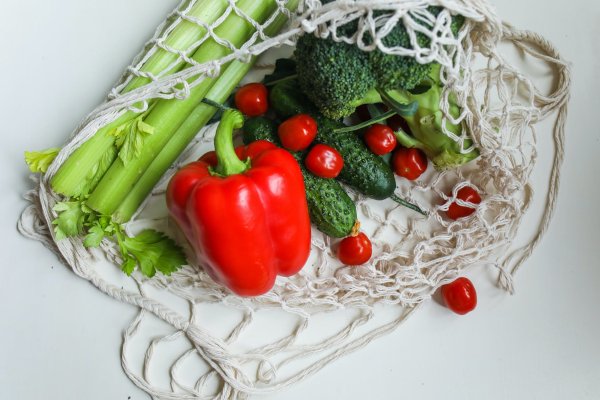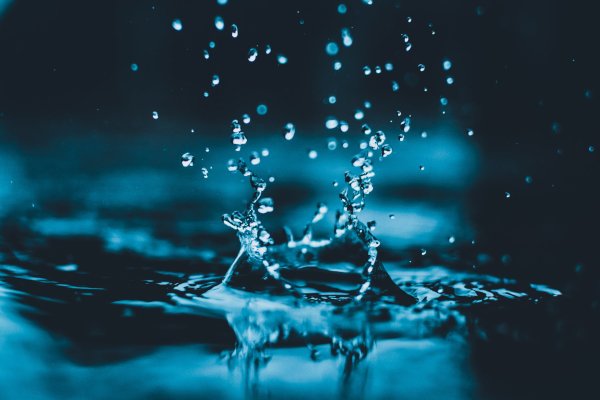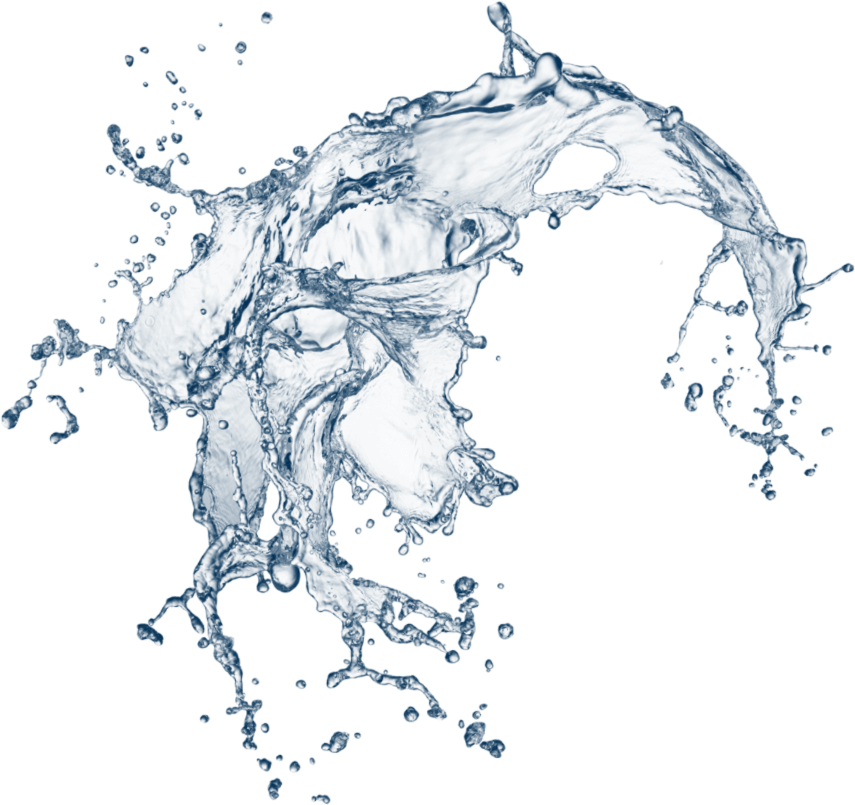
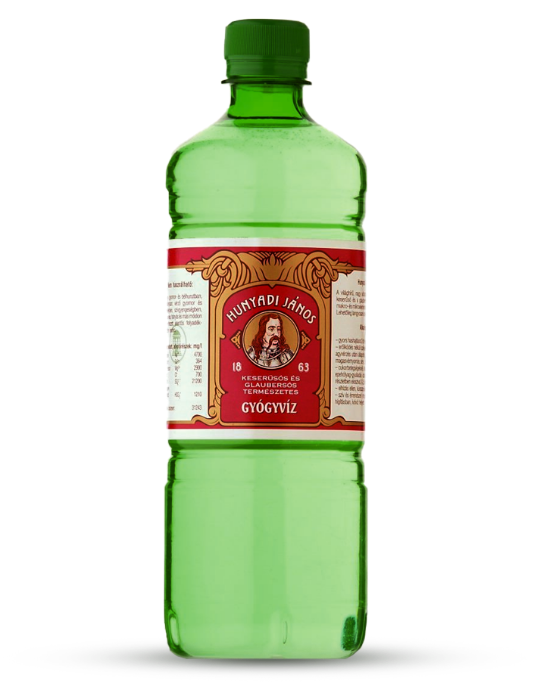
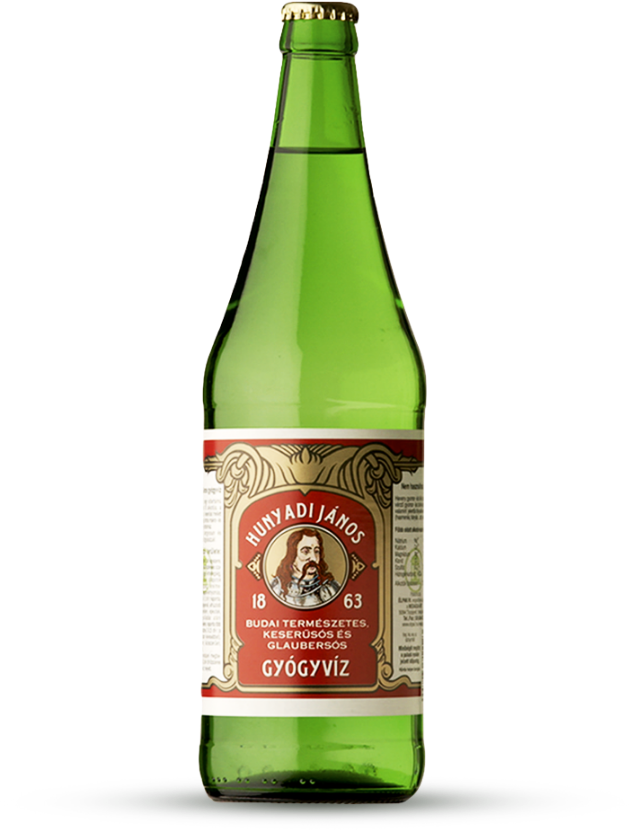
Hunyadi János
glauber salt curative water
| Magnesium (Mg2+): | 2160 mg/l |
|---|---|
| Sodium (Na+): | 5110 mg/l |
| Calcium (Ca2+): | 430 mg/l |
| Hydrogen-carb. (HCO3): | 738 mg/l |
| Sulphate (SO42-): | 18700 mg/l |
| Chloride (Cl-): | 660 mg/l |
| Sum total of ingredients: | 30200 mg/l |
Character
The two main ingredients of Hunyadi János curative water, known and used since 1863, are sodium sulphate and magnesium sulphate.
Indtications
Glauber salty (sodium sulphate) curative waters are characterized by their laxative feature and their curative effect on mild cases of colitis. The curative water rinses the intestinal walls, dissolving the bacteria and the inflamed discharge, which are then emptied with the stool. Unpleasant complaints that accompany catarrh, such as pain and the feeling of being bloated decreases and then disappears as a result of the bowel having been cleaned out. The curative water can be used with success for effortless bowel movement, which is very important for diseases of the cerebral veins, conditions following stroke, hemorrhoids, arteriosclerosis, and hernia. The curative water is an effective component in the treatment for certain gall bladder diseases; its use also decreases the risk of gall stone formation. With the effect of the sodium sulphate and magnesium sulphate curative water, the gall-bladder contracts, and the flow of the bile fluid into the bowels increases. The long-term consumption of sodium sulphate curative water helps in regularly emptying the gall bladder and in increasing bile secretion, as a result of which gall stone formation in the gall-bladder and the danger of inflammation decreases. When consumed after meals, the curative water hinders the absorption of fats and proteins, therefore, it can be used as a diet supplement.

Dosage
For one-time purgation, the consumption of 2 dl of the curative water is necessary. If you consume the curative water in a concentrated form, the effects will appear only 12-24 hours later; if you consume it lukewarm, on an empty stomach diluted with water (50-50%), the effects will appear within 1-2 hours. (This is also supported by Dr. Tamás Sándor's studies on the initiation of postoperative intestinal function in surgical patients.) Dr. Sandor Tamas professor's examination, intended to actuate the intestinal functions of surgical patients after their surgeries, supports this. The curative water should be consumed on an empty stomach, half – one hour before meals; for the treatment of intestinal catarrh, a daily amount of 1-2 dl is recommended, as part of a cure. In the case of the functional disorder of the gall bladder, liver diseases and diabetes, the consumption of 2-3 dl is recommended daily, taken in several smaller portions. For the purposes of slimming cure, against obesity, the daily consumption of three times 1 dl of the curative water is recommended, following the main meal.

The product cannot be used in the following cases
In the event of acute gastric and intestinal catarrh, lack of gastric acid, bleeding gastric and intestinal ulcer, the weakness of the heart, as well as diarrhea, vomiting and significant loss of fluids brought on by other reasons.
Historical survey
Of the laxative medical waters, the oldest and most well known is the Hunyadi Janos curitive water. It was made well known through the course of research in 1862, in the the 11th district, in the valley of Sas hegy and Sasadi-dulo, between the Dobogoi, Koerberki and Ormezei hills. Instead of drinking water, the owner of the land found bitter water in his well. Saxlehner Andras, while searching for baize during his examinations, recognized the valuable mineral traits of the water, and bought the land. He established the area and put the bitter water in circulation under the name of Hunyadi Janos. The medical agent of the bitter water is sodium and magnesium sulphate. Authorities like Liebig, Bunsen, Dresenius, Ludwig, etc., chemically analysed the medical water.
The Hunyadi Janos bitter water got in circulation in the Monarchy at first, then it was transported abroad. The product was in demand in five different parts of the world within a few years. Two million bottles got in circulation in the first ten years, then most of the fifteen million bottled waters were exported in 1913. Saxlehner Andras built a trade railway and connected his site to the kelenfoldi station in 1888. From this time on, transportation was done by train in every direction. Demand for bitter water decreased during the the two World wars. But these days, the consumption of curative water is booming again.
Logistics data
Volume/l:
Packing:
Collection:
Collection/pallet:
Bottle/pallet:
EAN code:
0,7 l
returnable
12er crate
32 (8x4)
384 (32x12)
5997263711123
Volume/l:
Packing:
Collection:
Collection/pallet:
Bottle/pallet:
EAN code:
0,7 l
one way
10er shrink wrapped pack
68 (17x4)
680 (68x10) 5997263711222

PLEASE HELP OUR WORK BY COMPLETING THE QUESTIONNAIRE BELOW.
Questionnaire

